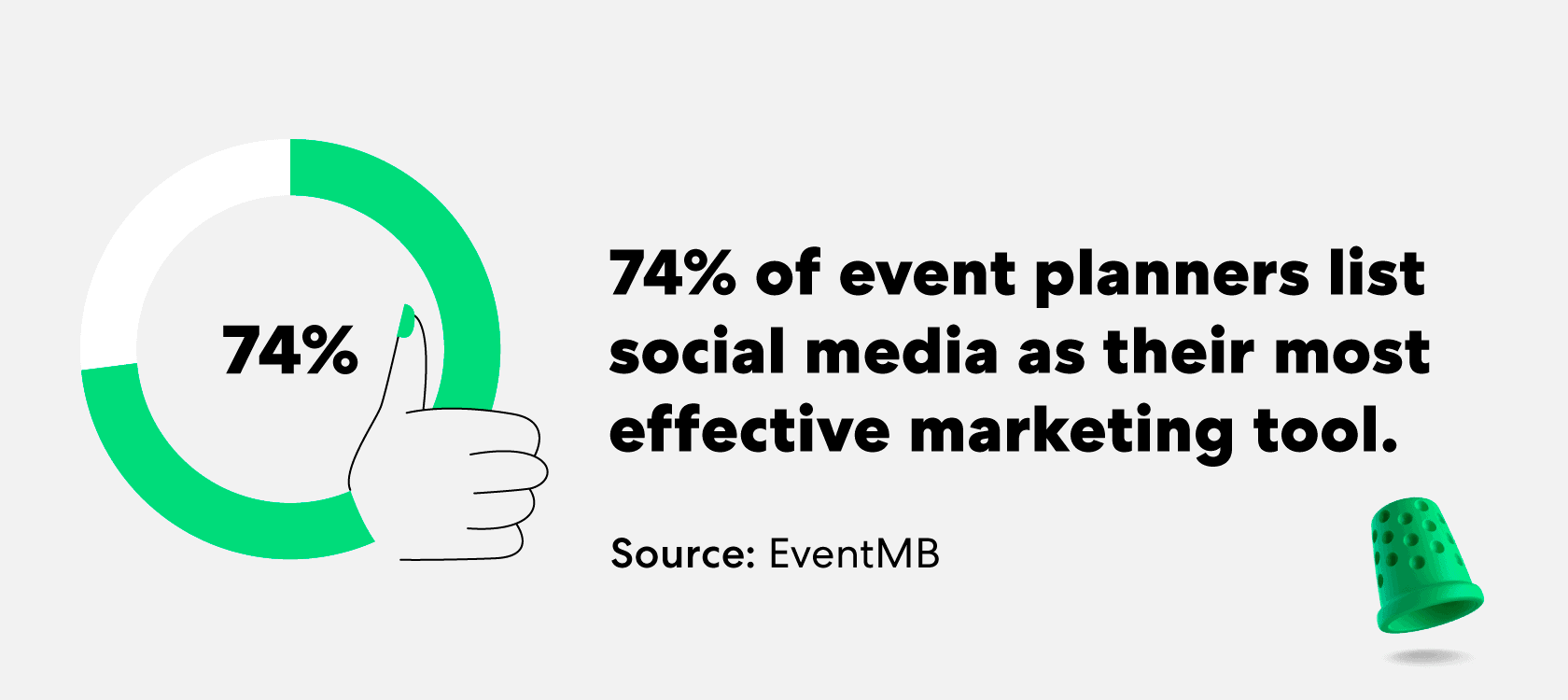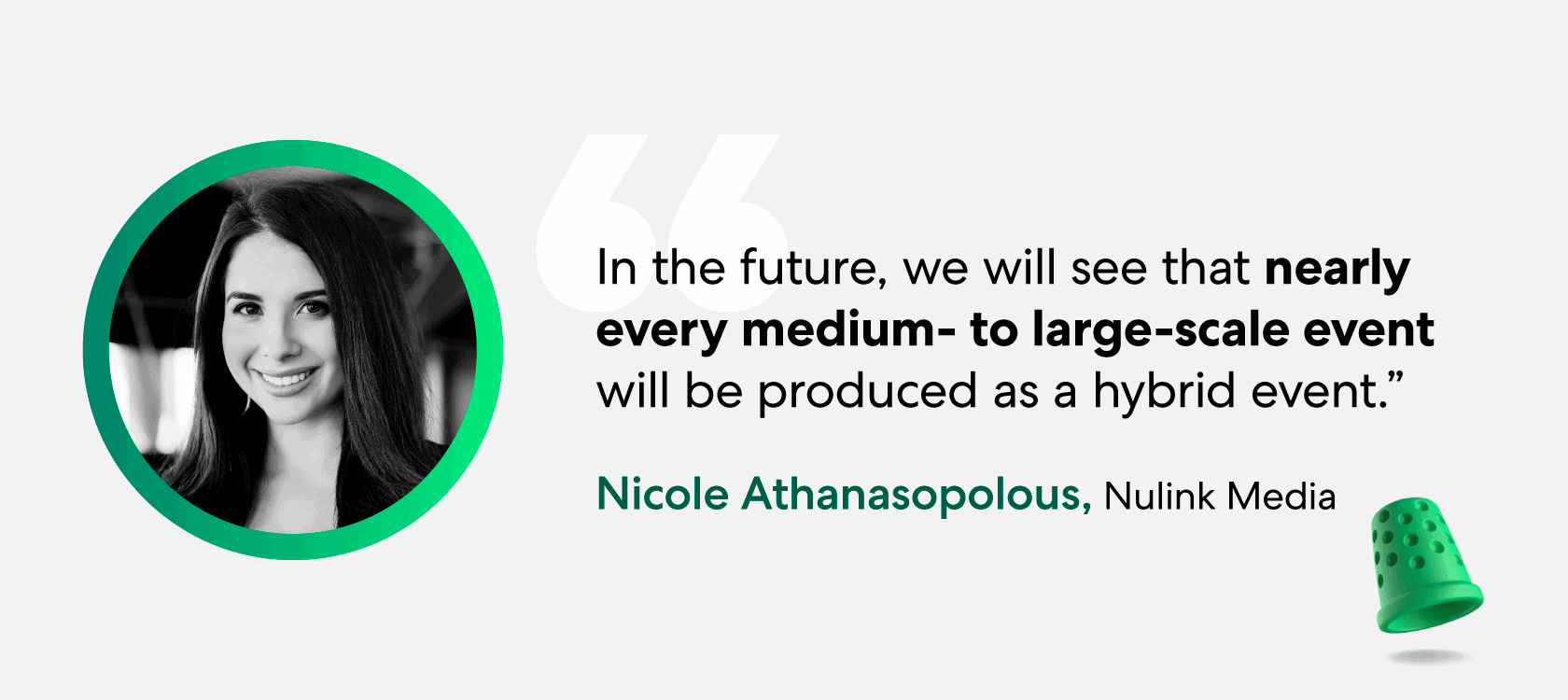Hybrid events are blends of physical and digital experiences that allow your audience to choose how they attend. So basically, if you’ve ever sat on your couch cheering on your favorite sports team while a live audience cheers from the stands, you’ve attended a hybrid event. When running a hybrid event, you provide both a physical space and digital experience that your customers can take advantage of.
Though hybrid events have been around for years, the COVID-19 pandemic led more people to rely on digital experiences in order to comply with social distancing guidelines. Thus, 34% of event organizers1 expect to invest more in hybrid events in the next few years, and nearly 60% are counting hybrid events as crucial parts of their 2021 strategy2.
Let’s break down some of the most important considerations for those organizing a hybrid event.
Types of hybrid events
Hybrid events have traditionally been coordinated by large companies putting on a conference, trade show or marketing event. However, social distancing guidelines have disrupted the event industry altogether, leading everyone from these big companies to smaller scale event planners searching for a way to go digital.
Hybrid events can span many different genres, from large meetings to small gatherings. Here are a few examples of events that could work in the hybrid format:
- Conferences
- Sporting events
- Weddings
- Exercise classes
- Meetings
- Marketing events
- Trade shows
- Seminars
- Product launches
- Workshops
- Art or cooking classes
- Trainings
- Concerts
- Theater performances
- Award ceremonies
- Trivia games
How do you run a hybrid event?
A hybrid event doesn’t necessarily require double the planning, but it does require attention to detail for both the virtual and physical audiences.
Coordinate activities
The first step in coordinating a hybrid event is choosing an activity that translates to a physical and digital audience. This could mean anything from a talk or conference to a lesson or game. For example, you can teach an art lesson that is conducted both in person and simultaneously live streamed for an at-home audience. When choosing an event, make sure you put a focus on engaging both audiences. Ask yourself: what can be enjoyed both physically and virtually?
Choose a virtual platform
Your virtual platform will be crucial for engaging and keeping your virtual audience. You’ll want an accessible, streamlined platform that is easy to set up and use. You’ll also need to take your audience size into consideration, as well as what type of event you’re hosting. Different video streaming platforms will have varying capabilities in terms of bandwidth and features.
Here are a few virtual event platforms to consider for the digital portion of your event:
What is a hybrid event platform?
A hybrid event platform will host the virtual portion of your event, but can also provide valuable insights into audience size, registration and engagement numbers. You’ll want to shop around for a platform that is within your budget while still providing features that will help make your event a success. For example, some hybrid event platforms provide features that others don’t, such as live polls and surveys. Others allow social media integration or video recording. You’ll need to determine your needs beforehand, then look for the platform that checks most of your boxes.
Advertise your event
Marketing for a hybrid event will be similar to marketing for an in-person event. However, you can take advantage of both digital and physical advertising methods to drive attention and reach a large group of people who can actually attend your event. You can use email marketing campaigns and social media to reach out to a digital audience, and billboards and signs to reach your physical one.
Most marketing will likely remain in the digital realm, as Event MB reports that 74% of event planners3 listed social media as their most effective marketing tool. And with a smartphone or tablet, you can use geotargeting to get your event seen by people who live in the area as well as those who could attend digitally. Emphasize to your prospective audience that the physical event will be safe — but for those who can’t make it, there’s a virtual option.
Engage your virtual audience
We’ve all lost interest while watching a video or attending a virtual meeting, so one of the hurdles you’ll have to overcome with your virtual event is keeping your digital audience engaged. The first step to doing this is making sure your platform can support high-quality video streaming that doesn’t lag. You can also engage your digital audience with a live social media feed or chat room to encourage discussion between audience members.
Dion Beary of Jumbo said virtual events find success through engagement. “A successful hybrid event can’t just be a video feed of an in-person event,” Beary told us via email. “Think about why Twitch became so successful for live streaming when YouTube already offered the capability: it’s because of live engagement tools. A great hybrid event should offer the at-home audience the chance to participate in the event in just as impactful of a manner as those who are in-person.”
Communicate with both audiences
Organization is key to making any event run smoothly, but perhaps even more so when you’re running an event with so many moving parts. You’ll need to communicate thoroughly with both of your audiences to make sure everyone attending your event knows exactly what to expect and how to access the activities.
Provide direct, clear instructions for those attending from home. Give them the information needed to log on without complication or download your materials quickly and easily. For those attending in person, make sure they know the rules, where to go and what to expect.

How do you promote a hybrid event?
Event promotion can be a tricky business. While running a hybrid event allows you access to a bigger audience, actually connecting with and finding that audience can still present the same struggles as an event that is exclusively held in person. Use a mix of digital and physical campaigns to reach your audience and garner interest.
Some popular methods for event promotion include:
- Emailing your contact list
- Using social media hashtags
- Advertisements in newspapers and magazines
- Billboards or signs
- Running paid advertisements on social media
What are the benefits of hybrid events?
Though hybrid events have increased in popularity since the COVID-19 pandemic led to stricter social distancing guidelines, they’ve been around for a long time. There are many benefits to running an event with both a physical and digital component.
Increased reach and attendance
With a physical event, your audience is limited to those who can travel the distance to attend and the number of people that will fit inside of the venue you choose. When you add a virtual component, you open your event up to more people who can log on from their own homes or workplaces.
Valuable data and metrics
A digital component allows you to collect more data about your audience. You can see exactly how your audience behaved during your event, including the demographics of people who were most interested, when the majority of people were most interested and when people checked out. This can help coordinate your future marketing efforts and event planning.
Greater flexibility
Though people might be interested in your event, they might not be willing to travel or plan their schedule around attending. Hybrid events provide flexibility for people who want to attend only a portion of the event or want to attend without coordinating travel. Plus, if you record the event for later viewing you can provide an even greater convenience for people with hectic schedules.
Increased ROI
An event that hosts a virtual component will likely make more money than it spends. The virtual audience is still paying for tickets, but you won’t have to spend money to accommodate this audience with catering or venue capacity. Therefore, the return you get from your investment will likely be higher than if you host an event that is solely in-person.
Who can benefit from hybrid events?
Hybrid events can be useful across a number of industries. As more people become accustomed to digital services, meetings and video experiences, even more businesses and services are finding ways to communicate virtually with their customer base.
Any event planner or industry that can imagine a virtual component for their event can benefit from throwing a hybrid one. For example, a wedding planner could make their event hybrid by providing a live video streaming service. A personal trainer or yoga instructor could do so by live streaming their classes for people to watch.

The future of hybrid events
Hybrid events, in some form or another, are here to stay. Now that people have seen the benefits of these types of gatherings, many industry professionals expect that customers will expect some sort of convenient offering. We asked three event industry professionals for their predictions on the future of hybrid events.
- “In the future, we will see that nearly every medium- to large-scale event will be produced as a hybrid event. The future of hybrid events is one where engaging content is at the forefront of the strategy and execution. The content is what ultimately keeps your in-person and virtual guests interested and engaged with your event.” — Nicole Athanasopolous, Nulink Media
- “Moving forward, I won’t be surprised to see more couples incorporate 3D, 360-degree cameras at their wedding ceremony so that folks who can’t be there in-person for whatever reason can enjoy the ceremony as if they’re right there in the front row to witness the couple live. Wedding professionals should expect to get requests about virtual components of the wedding to be implemented as part of their wedding services.” — Ivy Summer, Voulez Events
- “In the future, I see hybrid events becoming almost indistinguishable from attending physically. I’m a strong believer that technology will enable the next generation of hybrid events. Today we join most virtual events through our laptops or phones, but in the near future I think we’ll see virtual and augmented reality become the norm. Even joining a meeting in a holographic form may not be something that we only see in a Star Wars movie for much longer.” — Neil Parker, Lovecast
Hybrid events and small businesses
Though hybrid events are usually seen on a grand scale with events like MozCon and Apple Special Events, small businesses can log in too. In fact, small businesses reported welcoming 10 to 20 people to hybrid events for training or workshops, while 25% of medium-sized businesses reported having 20 to 50 attendees1.
Small businesses can use hybrid events to connect with a larger audience that is still interested in your product, even if they aren’t close to your location. For example, a personal trainer or fitness instructor could use a hybrid event to live stream a workout class while teaching it in-person to a few attendees. Meanwhile, an event professional could live stream a performance to people who can’t make the physical show, earning ticket sales from both audiences and providing a unique and flexible experience.
Most SMBs report a half and half audience split for their hybrid events, with 56% joining in person and 44% joining online1. This provides opportunities for business owners to connect with their in-person audiences and make those networking connections, while still scoring business from those who are out of town.
We’ve broken down more helpful hybrid event insights below.

Event planners already have a lot to think about. Adding a virtual component to an event? Yet another to-do on the checklist. So when it comes to event insurance for your event planning business, let Thimble handle it.
Sources:











